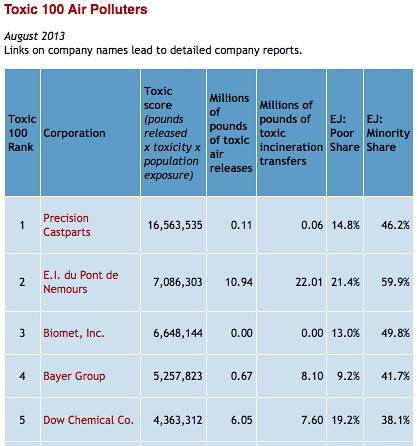
The headquarters of Precision Castparts is in this Portland office building.
Sloan Chambers/OPB
Portland-based manufacturer Precision Castparts has denounced a study that recently ranked the company number one in the nation for toxic air pollution. A news release from the company called the study grossly misleading and based on flawed assumptions.
The Toxic 100 Air Polluters list was released last week by the Political Economy Research Institute at the University of Massachusetts-Amherst. And Precision Castparts was at the top of the list.
Precision Castparts manufacturers parts for airplanes, engines and other equipment at 151 facilities worldwide. The University of Massachusetts study found air emissions of three metals from the company's U.S. plants were responsible for 99 percent of the estimated toxic risk to people nearby: Chromium, cobalt and nickel.
But the company claims the study inflated the toxicity levels associated with its metals emissions.
Click image above for full report.
For example, the company said, in some cases most of its chromium emissions were assumed to be the most toxic form of chromium when really most of its facilities' emissions are a less toxic form of the metal.
The study's co-author Michael Ash says it used the Environmental Protection Association's toxicity level estimates, which aren't as specific as he would like them to be.
The EPA requires companies to report emissions of chromium and chromium compounds, but it doesn't require them to distinguish between the more toxic form, hexavalent chromium, and the less toxic form, trivalent chromium. Hexavalant chromium increases the risk of lung cancer in people when it's inhaled, according to the EPA. Trivalent chromium is actually an essential element in the human body, and has shown to have moderate toxicity in animal testing.
In lieu of detailed reporting on which type of chromium is being emitted by individual facilities, Ash says, the EPA considers the type of facility releasing the pollutant to estimate the human health risks associated with those emissions.
In Precision Castparts' Oregon facilities, the estimated percentage of hexavalent chromium within the total chromium emissions was 3 percent. In other facilities in California, the EPA estimated 65 percent of total chromium emissions were the more toxic form.
In one of those facilities, Precision Castparts' Air Industries plant in Garden Grove, Calif., the company says nearly all the chromium emissions are actually a metal dust with very low toxicity.
Ash said his study used the EPA's estimates to do the rankings for the Toxic 100 list.
"We did not assume that all of Precision Castparts toxic releases are that toxic," Ash said.
Precision Castparts also argued that Ash's study misused data provided by the EPA to reach conclusions about the risks posed by individual facilities. The EPA stipulates that data from its Risk Screening Environmental Indicators model, which was used to develop the rankings in the study, should not be used "to conclude that a particular chemical release is causing harm to a specific population or location" or to "draw conclusions ... about the risk posed by any particular facility."
Ash says he is comfortable with the way his study used the EPA's data.
"I think we've used it as a screening tool to initiate additional conversation and an examination of potentially risky releases," he said.

